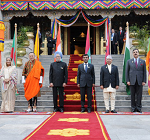The 17th SAARC Summit will be held this week, from Nov 10-11, in Addu Atoll in the Republic of Maldives. The theme, “Building Bridges,” captures the developments for India in the region for 2011 appropriately. Our relationships with our neighbours have seen vast improvement this year. India-Bangladesh relations are at an all-time high as both countries cemented their relationship with the resolution of long-standing territorial disputes. The Nepalese Prime Minister Baburam Bhattarai’s visit to India and the signing of the landmark agreements on investment protection has ushered in a new era in the India-Nepal relationship. In October, India stepped up its role in Afghanistan by agreeing to train Afghan military. And Pakistan finally gave India the long-awaited Most Favored Nation (MFN) status, bringing India at par with Pakistan’s other trading partners.
The journey to creating a neighbourhood of compatible interests was not easy, and whether this momentum can be maintained remains to be seen. First there was the refusal of Bengal Chief Minister Mamata Bannerjee to accompany the Indian Prime Minister to Bangladesh in September, and the subsequent derailing of the much anticipated water-sharing agreement. Then there was the opposition that Nepalese Prime Minister faced from his own party for visiting India. These have exposed the fragility of the political structure within which countries in the region have to make progress.
Nevertheless, progress is being made at a bilateral level on sensitive issues. The historic land boundary demarcation treaty between India and Bangladesh can set the precedent for similar agreements with other nations. The two sides signed the landmark agreement to swap 162 enclaves, settling an issue unresolved since partition, and helped resolve security issues such as cross border insurgency and illegal immigration. India’s decision to abolish 61 tariffs for Bangladesh, including 46 politically sensitive textile tariffs, is a goodwill gesture to help the Bangladesh government balance trade, which is currently in India’s favor. Indian exports to Bangladesh are nearly ten times the value of its imports (and even higher if informal trade flows are included).
Expanding this commercial liberalization to other countries should become easier with the political and economic transitions taking place in the region. Nepal ended its decades-long civil war in 2006, replacing its monarchy. The Sri Lankan government regained the last area controlled by Tamil Tigers in 2009. Growth rates have ranged from 4% to 10% the last few years for the South Asian Association for Regional Cooperation (SAARC) region, and even Pakistan’s awarding of the MFN status to India, though late and perhaps still only symbolic, is important. India and Nepal can follow up on the current upswing in their relationship to sign long-term hydro-power projects in Nepal.
Similarly, in Sri Lanka, India’s support of the government against the Tamil Tigers and a generous $1.5 billion in aid after the war, have laid the groundwork for a favorable disposition towards India. It is time that both nations settle long-standing disputes on fishing, and sign the Comprehensive Economic Partnership Agreement (CEPA), a step towards bilateral economic integration.
India and Bangladesh must provide an operational boost to the two historic accords – Framework Agreement on Cooperation for Development and the Protocol to the Agreement Concerning the Demarcation of the Land Boundary between India and Bangladesh and Related Matters – that were signed along with the memorandums of understanding in several fields such as renewable energy and conservation of Sundarbans.
Those are hurdles internal to SAARC. There are external hurdles, also, and they come in the form of China. The rise of Chinese engagement in the region, in terms of trade and security, has been rapid, making it even more important for India to play a leading role in the region. China is now Bangladesh’s biggest trading partner, as well as its largest supplier of arms. India reacted this year with an offer of US$1 billion credit line for improving transport infrastructure. In Nepal, China has agreed to invest $3 billion in Lumbini, the birthplace of the Buddha; it is a direct challenge to India’s slow-moving investment in reviving Nalanda, the ancient centre of Buddhist learning in the state of Bihar. China has also improved trade ties with Pakistan by signing a Free Trade Agreement with Pakistan in 2006, and is increasingly its international sponsor; India’s relations with Pakistan remains underdeveloped, to say the least.
It is hard to believe that most of South Asia was once a monetary union – a single nation. Now, the region displays what the World Bank describes as the lowest level of integration in the world. Intra-regional trade as a percentage of total trade in the region remains at a disappointing 5%.
It is not possible to revive SAARC without the member countries developing and maintaining strong bilateral relationships. India is well poised to lead that change, starting with the SAARC summit in November, now that it has evidence and experience of a new friendship with its neighbours.
Apeksha Kothari is a Research Intern at Gateway House.
This article was exclusively written for Gateway House: Indian Council on Global Relations. You can read more exclusive content here.
For interview requests with the author, or for permission to republish, please contact outreach@gatewayhouse.in.
© Copyright 2011 Gateway House: Indian Council on Global Relations. All rights reserved. Any unauthorized copying or reproduction is strictly prohibited.


